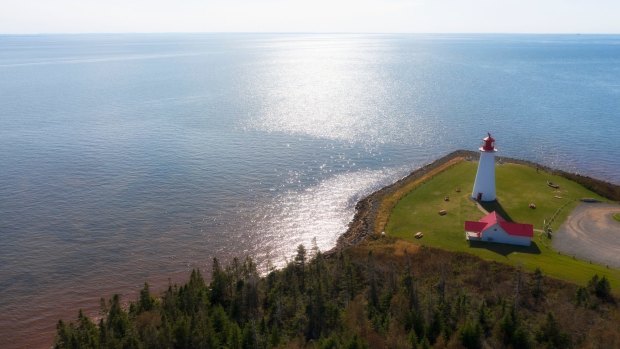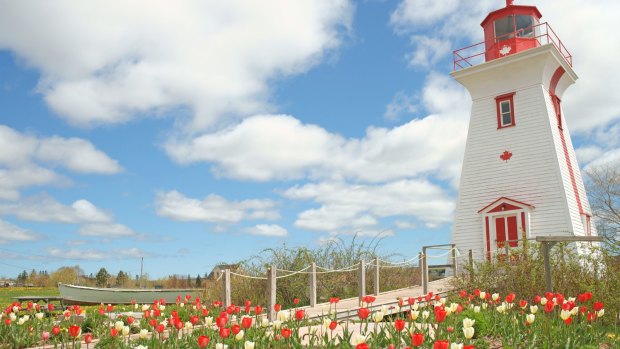This was published 3 years ago
Prince Edward Island: How Canada's smallest province kept coronavirus out

Point Prim lighthouse, Prince Edward Island.Credit: iStock
In the winter months, when icy conditions keep most people from travelling by sea, there are only two ways to enter Prince Edward Island: by plane or an eight-mile bridge.
When the coronavirus started spreading around the world earlier this year, Canada's smallest province, off the country's eastern coast north of Nova Scotia, found itself at a geographical advantage. The island's remoteness, paired with an aggressive isolation campaign that restricted nonessential travel and enforced two-week quarantines for those arriving in the province, paid dividends.
By late April, as death counts were ticking upward in other parts of Canada and the United States, the province had confirmed just 27 cases of the virus - all of them linked to off-island travel. None of those patients were hospitalised and no one died.

The lighthouse at Victoria by the Sea, Prince Edward Island.Credit: iStock
After going months without a trace of the virus, the island, home to around 157,000 people, is testing the waters of a cautious reopening, even as other countries rethink their leniency on internal travel. While Australia closes its borders between the country's two most populous states, travellers can once again, without a mandatory isolation period, move between Prince Edward Island and Canada's three other Atlantic provinces, New Brunswick, Newfoundland and Labrador, and Nova Scotia.
On Saturday, the island announced three new confirmed cases of the virus - but Heather Morrison, the province's chief health officer, told a news conference none were tied to loosened travel restrictions. Two more cases, also not linked to the bubble, were confirmed the next day.
The decision to start reopening is a welcome reprieve for some struggling business owners, many of whom feared they would call the summer season - when scores of tourists typically flock to the crescent-shaped island known for its red-sand beaches and fresh seafood - a total loss. But it's a far cry from a chance at complete recovery. The Canadian border is still closed to nonessential travellers from the United States. Last summer, cruise ships brought more than 128,000 visitors to Prince Edward Island. This year, none are expected to dock on its shores.
"It's still devastating for the tourism industry, there's no doubt about it," Matthew MacKay, the province's minister of economic growth, tourism and culture, said in a phone interview. But the "Atlantic bubble," he said, will be a game changer for many business owners, even if "there is a lot of fear still out there that we don't want to end up with cases."
The vast majority of Canada's roughly 105,500 coronavirus cases have been recorded in Quebec and Ontario, the largest provinces by population. All four provinces included in the new travel bubble have fared relatively well. Newfoundland and Labrador has confirmed only 261 cases and three deaths. In Nova Scotia, where the premier's plea for people to "stay the blazes home" went viral, 1,064 cases have been confirmed and 63 people have died. New Brunswick has recorded 165 cases and two deaths.
Despite the relatively low toll in the region, not everyone on Prince Edward Island sees the cautious reopening as a risk they are happy to take. The Canadian Press reported last week that some people with out-of-province license plates have shared on social media that their cars have been damaged or residents have expressed concern they could be carrying the virus. Some locals disagree with a policy that allowed hundreds of cottage owners to enter the island in recent weeks, ahead of the Friday bubble.
Even with the lifted travel restrictions, Kelly Doyle, president and co-founder of PEI Select Tours, does not expect clients this summer. His company caters to Japanese tourists, many of whom are drawn to the island by their love of "Anne of Green Gables," the 1908 novel by Lucy Maud Montgomery that is set on the island. His "bread and butter" tour offers visitors from Japan full-day immersion in the world of "Anne of Green Gables" and its author.
The pandemic has led to more serious losses than those Doyle suffered in the aftermath of other crises, such as severe acute respiratory syndrome, or SARS, he said. But with government protection programs in place to help business owners ride out the losses, Doyle thinks keeping the province isolated from the threat of the virus is a safer bet than reopening.
"For the few dollars that we're going to make from tourism, I don't see any need of opening it up," he said.
PEI Select Tours co-founder Katsue Masuda said some customers from Japan hope to be allowed back to the province soon. In the meantime, they are trying to keep clients engaged by posting photos on the company's social media accounts. "We are just building up their eagerness to come," she said.
Morrison, the province's top public health official, acknowledged that some people are concerned that an influx in visitors to the island could spark an outbreak. But the cautious reopening, she said, is a "balancing act between trying to protect people and recognising the social and economic impacts related to restrictions that are in place for too long."
"We are trying to move forward in lifting or easing up on a lot of these restrictions carefully and slowly because when we look to other countries and we see the increase in cases and deaths and many places that have not done so as cautiously, that is of concern for us," she said in a phone call. "I think Canada as a whole really has done a good job at not only flattening the curve but taking it down the other side."
Canada's Atlantic provinces are taking small steps to reopen as several US states reimpose restrictions after officials lifted shutdown measures. Huge leaps in case numbers have started to overwhelm some US hospitals and testing centres.
MacKay said that science led to the decision to reopen the Atlantic provinces and that officials will continue to follow their public health colleagues' guidance. Collaborating with health officials and closing the borders early, he said, is "definitely a big part of why we're doing so well now."
Isaac Bogoch, an infectious-disease specialist at Toronto General Hospital who is treating coronavirus patients, said in a phone call that Atlantic Canada's limiting the spread of the virus is likely due to a "combination of good policy, adherence to that good policy and geography."
Many Canadians are watching the rise in cases south of the border with "disbelief and concern," he said. "You need human health to have economic health."
Morrison said the deep sense of community and collective responsibility on Prince Edward Island has also gone a long way.
"Islanders have responded in such an unbelievable way to this COVID crisis and they truly together wanted to look out for each other," Morrison said. "I finish each press conference by reminding us that we're all Islanders, that we're working on this together and let's be patient with each other and kind to each other. And I think we really are doing that and are seeing the results."
The Washington Post
See also: The crazy phenomena that creates obscenely beautiful landscapes
Sign up for the Traveller Deals newsletter
Get exclusive travel deals delivered straight to your inbox. Sign up now.